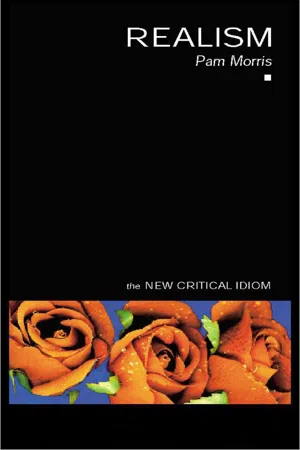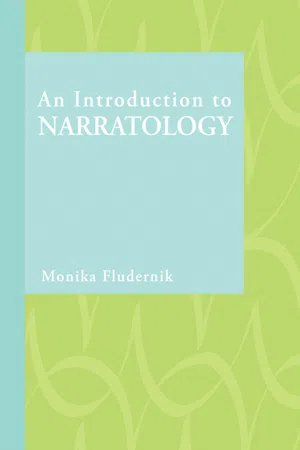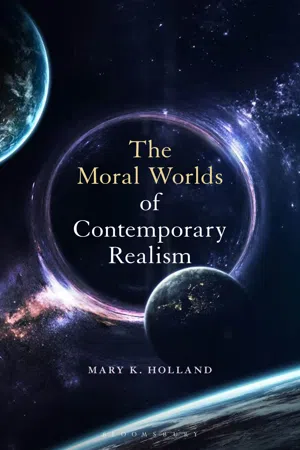Literature
Hyperrealism
Hyperrealism in literature refers to a style of writing that aims to depict reality with an extreme level of detail and accuracy, often blurring the line between reality and fiction. It emphasizes precise descriptions and meticulous attention to everyday life, creating a sense of heightened reality for the reader. Hyperrealist literature often explores the complexities and nuances of human experience in a vivid and lifelike manner.
Written by Perlego with AI-assistance
Related key terms
6 Key excerpts on "Hyperrealism"
- eBook - ePub
- G. R. Thompson(Author)
- 2011(Publication Date)
- Wiley-Blackwell(Publisher)
Chapter 2 Of Realism and Reality Definitions and ContextsAs a literary term, realism normally refers to a theory and practice of fiction in which the artistic goal is to portray “life as it is” – rather than intensified or as it should be – and in simple direct language rather than striving for striking metaphors and indulging in rhetorical flourishes. The elevated subject matter of classic tragedy, or the poetic elements of optative romanticism, or the sentimental aspects of domestic novels and romances, or the hair-raising events of gothic romances were to be downplayed or avoided in favor of the everyday, average, prosaic aspects of life.Realism in this sense was especially prominent in France, England, the United States, and Russia from about the mid-nineteenth century to the 1930s and 1940s (and beyond). But there are realistic, mimetic elements in works written centuries before: in the Iliad and the Odyssey (c. eighth century bc), in the plays of Sophocles (496–406 BC), in Boccaccio's Decameron tales (1351–1353) and Chaucer's Canterbury Tales (c. 1387–1400), in the plays of Shakespeare (1564–1616) and other Renaissance dramatists. Don Quixote (Part I, 1605; Part II, 1615) presents a hybrid form of a romance and novel in which the interplay of worldviews is centrally informed by the mixture of realism with idealized romanticism. Many consider this seventeenth-century work the cornerstone of the modern novel.In the English-speaking world, literary historians generally point to the principal eighteenth-century British novelists as anticipating the nineteenth century in the development of modern realism. In American literature, the primary meaning of realism indicates a period: the historical era from about a decade after the American Civil War to a decade or two after World War I.1 But literary realism, even when confined to a historical period, is not a single undiversified idea or theoretical program or movement. In both Britain and America, major fictional forms partaking of both realism and romance included the domestic novel , the novel of manners , and the sentimental novel . In America there was an important, predominantly realist, movement toward regionalism , within which broad rubric a form called local color is sometimes distinguished. Both centrally involve a forceful vernacular style (idiomatic spoken language), often in dialect (regional or ethnic idiom). In addition, we can identify, at the minimum, several forms of realist theory and practice in Europe and America: objective realism , compassionate realism , benevolent realism , and sentimental realism . There is also a distinction to be made between intense “social reformist” realism and “quiet” realism. Variations on realism and anti-romance are also in tension with, or in complementary relation to, impressionism and expressionism and most especially naturalism .2 - eBook - ePub
Super Bodies
Comic Book Illustration, Artistic Styles, and Narrative Impact
- Jeffrey A. Brown(Author)
- 2023(Publication Date)
- University of Texas Press(Publisher)
In every style the artist mediates between the reader and the story. “Realism” is no more real than any other artistic style used in comic books. Realism is a look that influences the tone, feel, and message of the story for a specific effect, in the same way that more obviously artificial styles, like Cute and Grotesque, do. Part of the perceptual dissonance that comes into play with Realism is because it appears to discard the genre’s more fantastical look, replacing it with an accurate depiction of real (or at least, possibly real) people in costumes. Recall that chapter 2 mentioned Richard Harrison’s observation in relation to arguments that superheroes present unrealistic gender ideals: “All of this analysis and talk treats comic book art as if it’s representational, as if the purpose of the artwork in a comic book is to draw characters as though they were human beings dressed up to play their superheroic or supervillainous roles” (2020, 351). Instead, Harrison continues, comic art is “a species of graphic art precisely because the drawings aren’t drawings of how characters look but of what the artists are telling the readers about them through the pictures” (351). In other words, to criticize superhero bodies drawn in the most conventional form of Idealism is futile because the bodies are exaggerated to signify an extreme of heroism, not to represent what people would actually look like in capes and tights. While this is an insightful way to explain how different artistic styles allow illustrators to convey different impressions (muscular heroism, nostalgia, horror, etc.), Realism confuses the issue precisely because the style means “to draw characters as though they were human beings dressed up to play their superheroic or supervillainous roles,” as Harrison argues (2020, 351) - eBook - ePub
- Raymond Williams(Author)
- 2013(Publication Date)
- Parthian Books(Publisher)
7 Realism and the Contemporary NovelThe centenary of ‘realism’ as an English critical term occurred but was not celebrated in 1956. Its history, in this hundred years, has been so vast, so complicated and so bitter that any celebration would in fact have turned into a brawl. Yet realism is not an object, to be identified, pinned down and appropriated. It is, rather, a way of describing certain methods and attitudes, and the descriptions, quite naturally, have varied, in the ordinary exchange and development of experience. Recently, I have been reconsidering these descriptions, as a possible way of defining and generalising certain personal observations on the methods and substance of contemporary fiction. I now propose to set down: first, the existing variations in ‘realism’ as a descriptive term; second, my own view of the ways in which the modern novel has developed; third, a possible new meaning of realism.There has, from the beginning, been a simple technical use of ‘realism’, to describe the precision and vividness of a rendering in art of some observed detail. In fact, as we shall see, this apparently simple use involves all the later complexities, but it seemed, initially, sufficiently accurate to distinguish one technique from others: realism as opposed to idealisation or caricature. But, also from the beginning, this technical sense was flanked by a reference to content: certain kinds of subject were seen as realism, again by contrast with different kinds. The most ordinary definition was in terms of an ordinary, contemporary, everyday reality, as opposed to traditionally heroic, romantic or legendary subjects. In the period since the Renaissance, the advocacy and support of this ‘ordinary, everyday, contemporary reality’ have been normally associated with the rising middle class, the bourgeoisie. Such material was called ‘domestic’ and ‘bourgeois’ before it was called ‘realistic’, and the connexions are clear. In literature the domestic drama and, above all, the novel, both developing in early eighteenth-century England with the rise of an independent middle class, have been the main vehicles of this new consciousness. Yet, when the ‘realist’ description arrived, a further development was taking place, both in content and in attitudes to it. A common adjective used with ‘realism’ was ‘startling’, and, within the mainstream of ‘ordinary, contemporary, everyday reality’ a particular current of attention to the unpleasant, the exposed, the sordid could be distinguished. Realism thus appeared as in part a revolt against the ordinary bourgeois view of the world; the realists were making a further selection of ordinary material which the majority of bourgeois artists preferred to ignore. Thus ‘realism’, as a watchword, passed over to the progressive and revolutionary movements. - I REALISM VERSUS EXPERIMENTALISM? 1 REALISM AND MODERNISM THE PRACTICE OF LITERARY REALISM Realism, I have suggested, is a notoriously tricky term to define. Even when limited to the realm of literary writing it has an aesthetic and a cognitive dimension neither of which can be wholly separated one from the other. Aesthetically, realism refers to certain modes and conventions of verbal and visual representation that can occur at any historical time. Yet realism is associated particularly with the secular and rational forms of knowledge that constitute the tradition of the Enlightenment, stemming from the growth of scientific understanding in the eighteenth century. Underpinning Enlightenment thought is an optimistic belief that human beings can adequately reproduce, by means of verbal and visual representations, both the objective world that is exterior to them and their own subjective responses to that exteriority. Such representations, verbal and visual, are assumed to be mutually recognisable by fellow human beings and form the basis of knowledge about the physical and social worlds. The values of accuracy, adequacy and truth are fundamental to this empirical view of knowledge and its representational form: realism. It follows from this that literary modes of writing that can be recognised as realist are those that, broadly speaking, present themselves as corresponding to the world as it is, using language predominantly as a means of communication rather than verbal display, and offering rational, secular explanations for all the happenings of the world so represented. Two central theses drive the argument I shall develop throughout this book: firstly, questions of knowledge and relative truth are inseparable from an understanding of realism as a representational form and secondly, our ability to communicate reasonably accurately with each other about the world and ourselves is what makes human community possible
- eBook - ePub
- Monika Fludernik(Author)
- 2009(Publication Date)
- Routledge(Publisher)
6 Realism, Illusionism and Metafiction Narrative realism RealismIn Ian Watt’s influential study The Rise of the Novel (1957), realism is presented as an essential defining feature of novels. Watt does not refer here to the nineteenth-century literary movement known as Realism, characterized by Sir Paul Harvey (editor of The Oxford Companion to English Literature, 1932) as concentrating on ‘truth to the observed facts of life (especially when they are gloomy)’. This literary movement goes back to a manifesto of 1857 by Champfleury (Jules Husson 1821–89), ‘Le Réalisme’. As we are all aware, it was a forerunner of naturalism (Zola, Gissing, Hauptmann) and originated in the desire of writers to distance themselves from romantic idealism, melodrama and a starry-eyed lack of concern for contemporary economic and social issues. The works of Stendhal, Balzac and Flaubert provide early examples of realism, but it is primarily the Goncourt brothers in France, Theodor Storm and Wilhelm Raabe in Germany, and the English novelists George Eliot, Anthony Trollope, Elizabeth Gaskell, George Moore and Arnold Bennett who are classed as literary realists.Ian wattIn Watt’s work, by contrast, the term realism is used in connection with matters of style and narrative technique to refer to characteristic features of the novel when it emerged as a genre in the early eighteenth century (between Defoe and Fielding). These characteristics set the novel apart from the romances of the seventeenth century and the tales of court intrigue modelled on French texts (Eliza Haywood). Watt notes that novels are no longer set at court but in the world of the middle or even the lower classes. They no longer take place in Catholic countries overseas (Italy, Spain, France) but in Britain, and here particularly in London. This reflects a shift to a more profound concern with real life. Financial, economic and social matters assume more importance. The action no longer takes place abroad at a splendid royal court and no longer involves idealized heroes and heroines driven solely by moral, political or emotional concerns (in other words the classic heroic conflict between love and duty). Instead, the story is adapted to a middle- (or lower-middle) class readership, reflecting their struggle to survive and the despicable motives (greed, jealousy, cunning, hypocrisy) that may underlie their actions. It describes how the emerging middle classes behave and what they hope for or fear. Watt points out the meticulous evocation of the fictional world in these works: it is depicted down to the very last detail. Novels, according to Watt, create a vivid world which, to a large extent, replicates that of their real-life readers, in contrast to the vague and frequently geographically and historically erroneous information provided in romances. The London of Defoe’s Moll Flanders or Fielding’s Amelia - eBook - ePub
- Mary K. Holland(Author)
- 2020(Publication Date)
- Bloomsbury Academic(Publisher)
However ultimately unsatisfying, Morris’s concerted efforts to define “realism” across the radically changing notions about language and reality of the twentieth century, and her characterization of that fiction in terms of meticulously examined “reality effects,” helpfully elucidate four problems inherent to any such act of defining:1.How do we distinguish realism as a period from realism as a set of techniques, or aims, or a value system (Enlightenment or otherwise), deployed in any time period? How can the term be useful without such a distinction?2.Given the profound change in scientific descriptions of reality in the twentieth century, does any definition of realism have to consider what it means be “real”? How might it do so? 3.How might our uses of “realism” differentiate between realist ways of reading and realist texts?4.Is metafiction, or self-reflexivity, as became a prominent feature in postmodern fiction, actually an inherent quality of all fiction, including realism, or is it a quality or technique that can be understood as opposed to realist fiction?In its attention to technical and formal innovations that characterize contemporary realisms, this book aims to begin to address exactly such questions raised by Morris’s and other earlier examinations of “realism.”Jameson’s Antinomies of RealismQuite in opposition to Morris—and to other post-modernist critics who look back on realism as always-already linguistically, epistemologically, and ontologically savvy, and engaged in the kind of ideological unmasking more often associated with poststructural texts—Fredric Jameson conceives of realism as a mode of writing that can neither deliver nor uncover truth, and is always invested in maintaining the status quo: “the realistic novel has a vested interest, an ontological stake, in the solidity of social reality, on the resistance of bourgeois society to history and to change”; “realism . . . is a hybrid concept, in which an epistemological claim (for knowledge or truth) masquerades as an aesthetic ideal, with fatal consequences for both of these incommensurable dimensions. If it is social truth or knowledge we want from realism, we will soon find that what we get is ideology.”84
Index pages curate the most relevant extracts from our library of academic textbooks. They’ve been created using an in-house natural language model (NLM), each adding context and meaning to key research topics.





